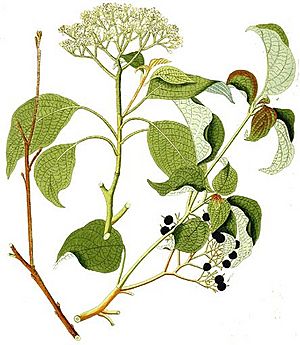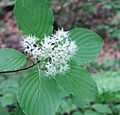Green osier facts for kids
Quick facts for kids Green osier |
|
|---|---|
 |
|
| Conservation status | |
| Scientific classification | |
| Genus: |
Cornus
|
| Species: |
alternifolia
|
 |
|
| Natural range | |
Cornus alternifolia, also known as the alternate-leaved dogwood or pagoda dogwood, is a cool plant found in eastern North America. It's a type of flowering plant in the dogwood family called Cornaceae. This plant is native to a large area, from Newfoundland in Canada west to southern Manitoba and Minnesota, and south to northern Florida and Mississippi. It is not very common in the southern United States.
Contents
What Does it Look Like?
The alternate-leaved dogwood is a small deciduous shrub or tree. This means it loses its leaves every autumn. It can grow up to about 25 feet (7.6 meters) tall, but sometimes even 30 feet (9 meters). Its trunk can be up to 6 inches (15 cm) wide.
Branches and Leaves
The branches of this tree grow in a special way. They form flat, horizontal layers, almost like a pagoda roof, which is why it's sometimes called the pagoda dogwood! The leaves are shaped like an oval or egg and are about 2 to 5 inches (5 to 13 cm) long and 1 to 2 inches (2.5 to 5 cm) wide. Unlike most other dogwood trees, its leaves are arranged alternately on the stems, not in opposite pairs. They often grow in groups at the ends of the twigs, making them look like they are in a circle. The top of the leaves is smooth and green, while the bottom is a bit hairy and bluish. In autumn, the leaves turn yellow, or a mix of yellow and scarlet, which looks very pretty!
Bark and Flowers
The bark of the tree is gray to brown. As the tree gets older, the bark gets more ridges. Small, cream-colored flowers appear in spring, usually in April or May. Each flower has four small petals. These flowers grow in clusters called cymes, which are about 2 to 5 inches (5 to 13 cm) across. After the flowers, the tree grows small, blackish-blue berries. These berries are about 0.3 inches (0.8 cm) wide.
Where Does it Grow?
This tree likes to grow in places where there are other deciduous trees that lose their leaves, but with enough open space. You can also find it along the edges of forests and wet areas like swamps. These trees prefer soil that is moist but also drains water well.
Young alternate-leaved dogwood trees can grow well even in shady spots. This means you often see them growing under taller trees in old forests, like those with sugar maple or Populus (aspen) trees. They are also common in younger forests.
How Does it Help Animals?
The fruits of the alternate-leaved dogwood are an important food source for many animals. At least eleven different kinds of birds love to eat these berries. Even the black bear enjoys them! The leaves and bark of the tree are eaten by animals like white-tailed deer, beaver, and cottontail rabbit.
How Do People Use It?
People really like the alternate-leaved dogwood because of its unique look. Its wide, layered branches and flat top make it a popular choice for planting in gardens and parks. While its flower clusters are pretty, they don't have the large white leaf-like structures that the flowering dogwood has. Also, its fruit is dark purple instead of red.
There's a special type of this tree called 'Argentea', also known as the silver pagoda dogwood. It's so beautiful that it won an important award called the Royal Horticultural Society's Award of Garden Merit in 2017!
Sometimes, C. alternifolia can get a plant disease called golden canker. This happens more often if the tree is stressed by not enough water (drought) or too much heat. To help prevent this, it's best to plant the tree in a spot that gets some shade, and make sure it has enough water and mulch around its base.
In traditional Chinese medicine, the Cornus alternifolia has been used for different purposes. It was thought to help as a tonic, to relieve pain, and to help the body get rid of extra water.
Gallery
See also
 In Spanish: Cornus alternifolia para niños
In Spanish: Cornus alternifolia para niños





